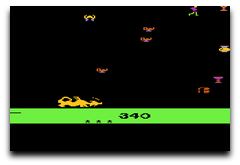 Now here is another interesting video game for the Atari 2600, the game Dragon Fire consisted of two game screens, one which you ran across a bridge while fireballs were shot at you, you had to duck or jump over the fireball. This screen was a side-scroller style screen (although it doesn’t actually scroll), at the other end of the bridge was a castle door which you’d enter to get to the next screen.
Now here is another interesting video game for the Atari 2600, the game Dragon Fire consisted of two game screens, one which you ran across a bridge while fireballs were shot at you, you had to duck or jump over the fireball. This screen was a side-scroller style screen (although it doesn’t actually scroll), at the other end of the bridge was a castle door which you’d enter to get to the next screen.
The second screen was more classic “overhead but not really” screen where you ran around this black screen picking up treasures while a dragon at the bottom shot fire at you from below.
As the game increased in level jumping fireballs became more challenging (on the first screen) as you ran because they would come quicker, more often. The second screen would get very difficult very quickly as the dragon would increase in speed and fireball spitting. You could tell how hard the dragon would be as it would change colors from lighter to darker black as you progress stages. When you finished collecting all the treasure an exit would pop up in the corner and you had to run to it without being burned by the fireballs, that dragon would turn from left to right nearly instantly too! Then, you’d jump into the exit and be back on the bridge again, but this time it was harder. You could die up to 7 times before the game was over (just to show you how hard it is, they gave you a bunch of lives).
When you finished collecting all the treasure an exit would pop up in the corner and you had to run to it without being burned by the fireballs, that dragon would turn from left to right nearly instantly too! Then, you’d jump into the exit and be back on the bridge again, but this time it was harder. You could die up to 7 times before the game was over (just to show you how hard it is, they gave you a bunch of lives).
The game was tough, frustrating, hard to replay because you were just so nervous and jittery from the last attempt. Graphics were “okay,” nothing to rave at but it was, after all, the 2600.
You can hear all we had to say about DragonFire for the Atari 2600 on Episode 79 of the TD Gaming Podcast!
Podcast: Play in new window | Download

 This year many gamers will open new consoles for the holidays and many of those same gamers are going bring their console “live” on Xbox Live the same day. Traditionally we’ve found Xbox Live falls under the weight of the holiday rush much like Apple’s iTunes. Will we repeat history again?
This year many gamers will open new consoles for the holidays and many of those same gamers are going bring their console “live” on Xbox Live the same day. Traditionally we’ve found Xbox Live falls under the weight of the holiday rush much like Apple’s iTunes. Will we repeat history again?
Greatest Atari 2600 game ever!!!